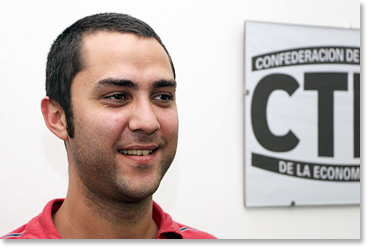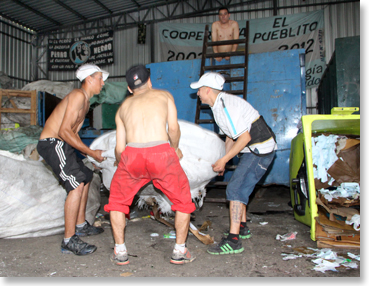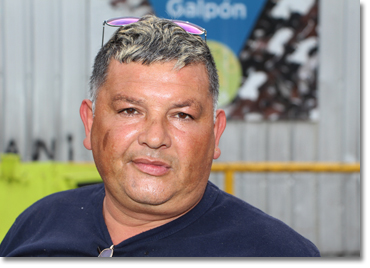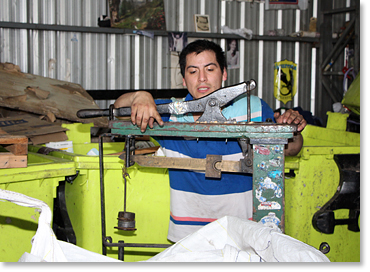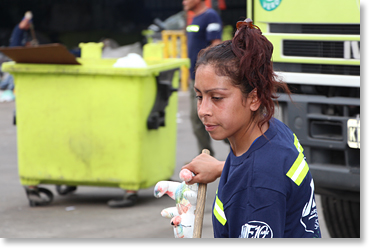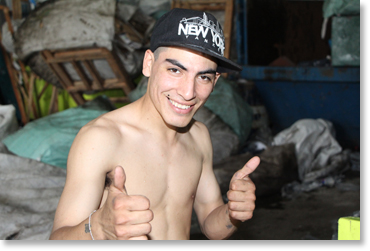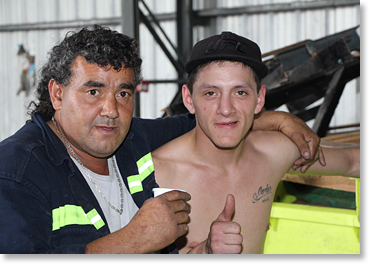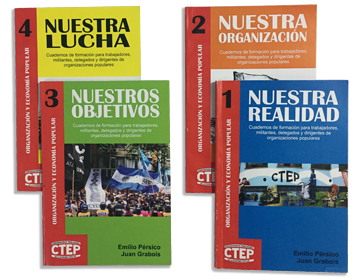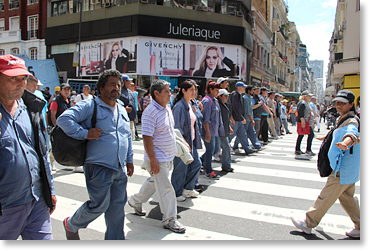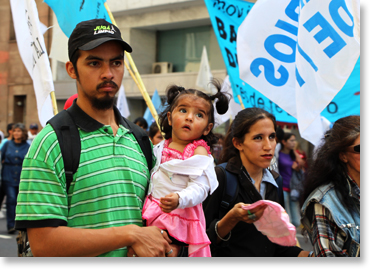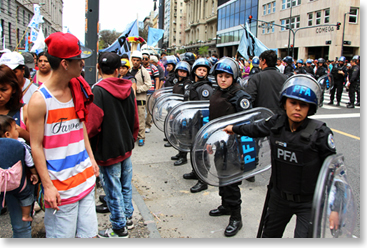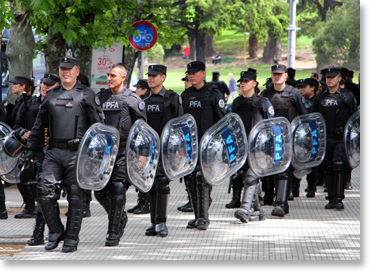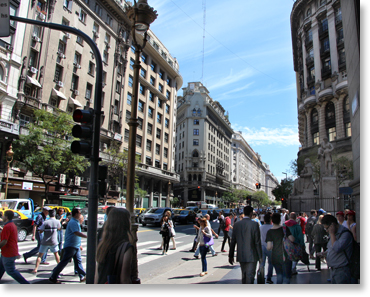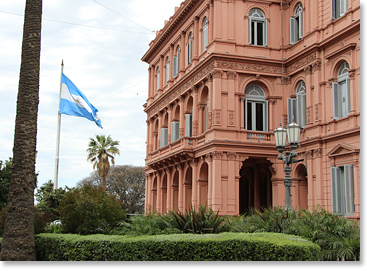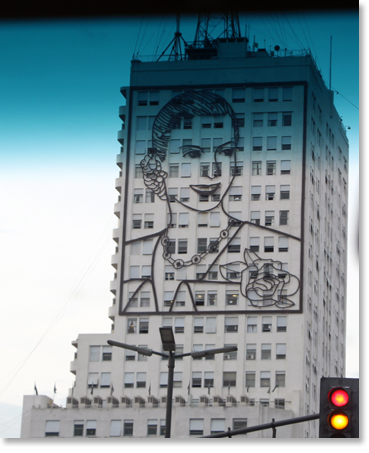|
Interview with Juan Martín Carpenco
Juan Martin Carpenco is an activist member of CTEP (Confederación de Trabajadores de la Economía Popular / Confederation of Workers of the Popular Economy). This interview was conducted (and later translated and edited) by Nic Paget-Clarke for In Motion Magazine on October 8, 2014 in Buenos Aires, Argentina. The interview took place in the offices of CTEP in the Constitución neighborhood. Quick Links:
In Motion Magazine: Can you please tell me a little about your life, your experiences? Juan Martin Carpenco: Let us say that I got close to this group of people because I was a resident of the Almagro barrio during 2002, which was when a great crisis happened (editor: Argentina’s Great Depression, 1998-2002) and which, as you must know, resulted in the resignation of five presidents, etc. And, it was when the phenomenon of the cartoneros became known to everyone. Do you know about the cartoneros? (Editor: the cartoneros are a movement of unemployed who survive by forming collectives to recycle cardboard and other items.) In Motion Magazine: Yes. Juan Martin Carpenco: Well, with Juan (editor: Juan Grabois – lawyer; member of the secretariat of CTEP; consulting member of Pope Francis' Pontifical Council for Justice and Peace.) and other friends, members of the neighborhood, we began to run a soup kitchen, food for people who were passing by there, as an act of solidarity, let’s say, without knowing what it would turn into afterwards, in ten years. That is because, at that moment, it was calculated that there were 30,000 cartoneros in the federal capital (the autonomous city of Buenos Aires) working in very, very difficult situations in the shadows. And all of society didn’t even understand what was happening with all these people who suddenly arrived in the capital looking for a way to subsist by collecting recyclable materials. So, we began doing the soup kitchen in 2002. We were serving food at night for people, for the cartoneros, and little by little we were understanding, comprehending, why there was such a phenomenon as that (the cartoneros). And, also, we were learning what were the only possible answers to being able to achieve improvement in the life of those people, of those families, because still, today, the state is not able to incorporate many of the processes of the people’s economy. (It) is not able to provide a response appropriate for this new individual in society who is not the same as a laid off worker; who is not an illegal worker (un trabajador negro); a worker who doesn’t have rights recognized by a union, or their employers, but who is a worker who generates wealth and works in a distinct way. In terms of the conflicts, the organization began to be structured around them. I am talking specifically about that organization called MTE "The Movement of Excluded Workers” (Movimiento de Trabajadores Excluidos), which is the organization which became the union of the cartoneros and that still is not a union because it is not granted the standing of being a union, which is the recognition that must be given to it by the Ministry of Labor. But, in practice, it functions as if it were a union because it has its elections, its authorities, its delegates. And, all of that was constructed over a base of conflict with, for example, the police, the federal police in the city of Buenos Aires. … This is an element of oppression for our fellow worker because they (the police) were charging him a bribe (coima) to work in the city. Do you understand “coima”? Money under the table is how this is done. Corruption. So, we began to fight so the police (would) not charge someone who doesn’t have a job, who doesn’t have any other way of surviving and that finds themselves in the trash as the only way of supporting their family. And, upon that struggle, an action began to be organized that today has 5,000 members who are organized in cooperatives. Well, it would take many years to tell about them all, but little by little we were coming into the street, with the people, and sharing this experience – that this problem was not going to be solved by the traditional means that the state, the most charitable of the states, has for the dispossessed, for the poor. So, that is specifically the issue of the cartoneros. But, afterwards, we began to see that wasn’t the only process of the people’s economy that existed in Argentina during those last years. That is, there were the recovered factories, like Zanón (editor: See Interview with Jorge Bermudez of Zanón -- FaSinPat). They are workers maintaining themselves above the baseline of subsidies -- a state program which was born as a way of seeking to eliminate poverty, from the economic point of view, but which doesn’t take into account the relevance that that has as to the dignity and the search for identity of that person who, otherwise, would not be able to subsist or keep going. The relationship with the state doesn’t have to be only “I give you this money”, but also (can be) about organizing yourself. It is a way to grow collectively and dignify that work which is done in the barrios. The Indigenous campesino movement is another expression of work, of economy, of generating wealth on the basis of subsistence and upon the basis of working communally as a group to challenge the market or to challenge those who are truly making money from the land. This is a little panorama of all this. In Motion Magazine: Who makes up CTEP here in Buenos Aires? Juan Martin Carpenco: CTEP is an organization in process, and, as we were saying, what it lacks to formally organize, to institutionalize the structure of CTEP, is precisely this beginning stage, this legal recognition as a trade union, which should be granted by the Ministry of Labor, which now isn’t being done. CTEP organizes itself in branches, first in branches, and afterwards by region, as it is going to be all over the country. There is going to be a CTEP in Neuquén. There is going to be a CTEP in the north. All over. The cartoneros on one side, the workers in recuperated factories on another, and peasants on another, etc. In Motion Magazine: Throughout the country? Not just here in Buenos Aires? Juan Martin Carpenco: We calculate that the population which can benefit from this type of organization, or at the very least the Argentinian population that works with these conditions that I described to you at the beginning, are 5 million people. People discarded by the labor market and people who do not work in a relationship of dependency with the state. That is, they do not work for either of the two poles of work of the traditional system. They have created a distinct way of living. In Motion Magazine: And how many are in the city here? Juan Martin Carpenco: Obviously, the majority are here because the federal capital concentrates the majority of the (national) population in the capital and the urban center. In Motion Magazine: In this city, your primary work is with the villas. Is that correct? Juan Martin Carpenco: With the Villero movement. They are also included. Yes. In Motion Magazine: How many people live in the villas? Juan Martin Carpenco: There are approximately 300,000 people who live in villas, in the federal capital alone. In Motion Magazine: Where do they come from? They tell me the majority are migrants from Bolivia, Paraguay. Is this true? Juan Martin Carpenco: And Peru. Migrants. In the federal capital this is true. The majority of the people that live in the villas are migrants. He doesn’t have a relationship of dependency with anyone In Motion Magazine: When you say that people are excluded, what does that mean? Excluded from what? Juan Martin Carpenco: Excluded from rights, from jobs; excluded from all the rights that the constitution provides for any citizen. That is, if one analyses it from the legal framework, the Argentinian worker, a cartonero is not a worker because he doesn’t have a boss, because he doesn’t have a relationship of dependency with anyone. That, there, is the key to what we call exclusion. There is no access to the right to a home. Let’s say it shines by its absence. All our compañeros live on lots that they continue to occupy and which they are winning from the property owners, many times spontaneously, many times in an organized way. But the accomplishment of the right to a home is generated basically by occupying plots of land that belonged to others, or state lands. Historically, there was always a crisis and there was always a mass of unemployed, of poor people. But the tendency was that when the country was growing, it would incorporate them again, or in other words it would give them work again. It would be giving to them. It was investing in hospitals; investing in housing. The crisis would return again, they would turn to the poor again. That is what is happening or what happened in the last decade. The tendency was, when there was an economic recovery, the people left out were dragged in. But, we have had almost 15 years of constant growth of the GDP (Gross Domestic Product) and the current situation for our compañeros continues the same -- as if something broke, in relation to the welfare state, for a great portion of society. Capital goods, technology, have replaced man In Motion Magazine: And would you say this is a new stage of capitalism? Juan Martin Carpenco: It is related to the Fordism method of work. That is, the factories that used to need 15,000 or 20,000 people in order to produce their merchandise no longer exist in any part of the world. Capital goods, technology, have replaced man in regards to producing their food, their electric household goods, everything. So, those people are never again going to enter into that system. It is necessary to invent a new system to dignify that part of the population. We cannot be clamoring and saying, “We want that you put us back in that factory” because that factory is not going to ever need us any more. In fact, let us say, the number of years that this has been taking place has caused the Argentinian wage for manual labor to be very low. That is, our capital is what is called here “the culture of work”: the necessity of being, of going out doing something -- first, to feed your children, to support your household; and second, to give meaning to your life. The cartoneros invented their work In Motion Magazine: How do people survive? Juan Martin Carpenco: We say that we invent our jobs. For example, the cartoneros invented their work. The recovered factories were workers on the last step of the ladder, of the hierarchical pyramid, who are now fulfilling functions such as management and administration. They had to learn how to run a company, an establishment, for example, with a cold storage room, or like Zanón, which is a company that makes floor tiles and ceramics. *The recovered factory is a very important symbol for Argentina. There are 350 recovered factories, not only Zanón. Eight percent of the factories in Argentina are recovered factories. (And) the farmworkers, for example, is a thousand-year-old task but now they are doing it in the little area that agro-business leaves them. Previously, the peasant was an important person. Up to the 1950s, he was a very important part of Argentina. Today, he is a minor character because of agribusiness, soy, and extractivism. And, let us say, the extensive work of the land is racing along and they (the peasants) have had to adapt in order to at least satisfy their own needs and produce their food. But the possibility of commercializing their production is only possible within the popular economy. That is, to succeed, for example, the peasants of Santiago de Estero sell their merchandise here, in the capital, to our compañeros, because they cannot go to a supermarket and compete against the big food companies. So, there is a part of their income that they generate through the strength of the work they do, whether it be recycling, or in other activities, and there is a very small part that comes from the subsidy granted by the state – this same one that we were talking about at the beginning. In Motion Magazine: And many jobs are organized in cooperatives? Juan Martin Carpenco: All. In Motion Magazine: What types of cooperatives? Juan Martin Carpenco: I think I should explain to you how some workers are involved with a state plan in Argentina called Plan Trabajar. Unemployed workers who enter the program receive a state subsidy and then they form a cooperative. You get that subsidy if you form a co-op. It is a way to go back to work. It is necessary to organize a cooperative and it is necessary to have a work focus such as cleaning up a creek bed, cleaning up a neighborhood, cutting the grass in the plaza. Many of the co-ops are involved in housing construction. They are tasks that benefit the community. And there are thousands of them. So, that is another branch of the excluded workers. There are the cartoneros, the peasants, the recovered factories, and the Plan Trabajar cooperatives. In Motion Magazine: How does a cooperative function? How many people are there in a cooperative? Juan Martin Carpenco: They vary. In Argentina Trabaja, for example, there are 35 to 50 people in each nucleus. The operation of the cooperative, the only thing that it intends to do is organize the work. That is, that there be a responsible leader, that there be someone who takes (this responsibility), that there be someone who gets the work uniforms and tools; that there be a work schedule; that there be a workday; that there be a place to work. Simply put, that is the function of the cooperative. In Motion Magazine: So it is not political? Juan Martin Carpenco: No, no. Yes! Professionally, let us say, the arranging of the work is the function of the cooperative. (But) it is not the same as the famous cooperative movement at the beginning of the century to sell grain and to be able to compete. It doesn’t fulfill the same function as a society (that is cooperative), the genesis of the cooperative movement. It is to distribute tasks. To distribute the money? No -- because the money is paid directly by the state. But, more than anything, it is to disseminate the purpose and vision behind the tasks, the vision of the work that makes it a cooperative, turns it into a cooperative. For example, each cartonero works by himself, leaves his house, comes to the capital (Buenos Aires), collects his merchandise, returns to his collective, and returns to his house. Now the colectivos (small vans used as small buses): the vans that are used, the uniforms, all that is accomplished in a collective way. The whole cooperative asks that each one have their uniform, so that each one gets a subsidy. The function of the cooperative is to unite this sector, but each cartonero on his own accord continues to accomplish his tasks. In Motion Magazine: How many cooperatives are there in the city? Juan Martin Carpenco: Just cartoneros, -- there are 20 in the Capital. The federation of cartoneros, at the national level, has 40 cartonero cooperatives. In Motion Magazine: And each cooperative has how many people? Juan Martin Carpenco: That depends: for example, Cordoba is a big city, it has cooperatives with 500 people; the one here has 3,000; the one in Rosario has 2,000. But there is one in Purmamarca that has eleven people. In Motion Magazine: Where do people meet? In churches or offices …. Juan Martin Carpenco: There are many locations where people talk to each other in each barrio, and generally, people meet together, visit with each other, frequent with each other, in the street. Now, we are a little more advanced and accomplished so that in each place there is a house, a place where people can meet. But at the beginning, the genesis of the movement, it developed in the street, all the meetings were in the street. In Motion Magazine: Are there assemblies in each villa? Juan Martin Carpenco: Yes. In Motion Magazine: Are they political? Not in the sense of electoral politics but … Juan Martin Carpenco: Yes, yes these are elements that are very important in the construction of all this. Debate and the clash of ideas, proposals, always takes place in the assemblies. In Motion Magazine: How many people are there in an assembly? Juan Martin Carpenco: It depends on the size of the cooperative. For example, the factory in which I am in is a recovered factory which has 350 workers. For the assemblies, we say, “Those go who want to go.” And always close to 100 percent go because everyone’s interests are in play. In Motion Magazine: Is there an assembly for each cooperative? Juan Martin Carpenco: Yes, there is an assembly for each cooperative. Here, there is an assembly for each cooperative, for all the sectors of CTEP. In Motion Magazine: With representatives present or with all the people? Juan Martin Carpenco: There are different occasions. For example, when there is a protest action to be made before the Ministry of Labor, everyone goes. But when everyday questions are being debated, no. Representatives come. There are different places where different issues can be dealt with -- gatherings of different assemblies to share problems and make decisions together. In Motion Magazine: Is it horizontal? (the decision-making) Juan Martin Carpenco: It is intended that it be as horizontal as it can be. That is, horizontality is a founding concept of CTEP. In Motion Magazine: Do you think that it is working? Juan Martin Carpenco: It is working, that is, a natural leadership exists that isn’t the same as a boss. It is one thing to be a leader, a person, a reference point, and another thing to be a boss, who is the one who pays you and coerces your reality because he manages the resources. That doesn’t happen here. Or, it is intended that it not happen. That is, CTEP would guarantee there would never be anything like that. It is against its principles. Now, there are leaders, people who stand out, but no one is more than others, than those who don’t stand out. In Motion Magazine: Do representatives rotate? Juan Martin Carpenco: Each cooperative holds direct-vote democratic elections, let’s say. Once every two years he/she changes their assignment. A theoretical and conceptual framework In Motion Magazine: Are there education workshops in CTEP? Juan Martin Carpenco: Yes, there are several. There are training workshops above all to understand the meaning and the importance of a cooperative and to teach what is the purpose of the assemblies. How assemblies come to be, how delegates are elected, how leaders are elected. Then there are trade workshops – trades like metal worker, those who work with metal, the young men “after-carton”, they are the sons of the cartoneros who make handicrafts with cardboard. Workshops for computer skills for adults and for the children of the cartoneros. While the cartoneros are working, their kids come here. This last month, CTEP, in collaboration with the University of San Martín, began a degree program. It is a course of a month and a half. It is a course of 30 days here in Buenos Aires at the University of San Martin and ten days in the Mapuche community in which you are going to be. Juan (Grabois) is going to be with the CTEP group of that zone who have made a training school there. Little by little we are going to have at least the great majority, or a significant part, of the compañeros who compose CTEP taking that training course to understand in depth this book (Organization and Popular Economy – in four parts), and to come out a little from the routine which at times is a little exhausting, and in some way enrich themselves, in terms of what they themselves created, but (also) give them a theory, give them a theoretical and conceptual framework. Of course, also, they are adults and so they share their experiences. And they have the opportunity to travel because the course is here in Buenos Aires and they travel there to San Martín de los Andes, in another province, to continue it there. Afterwards, they receive a special diploma from the University, which is important for the people. The Pope: To serve the most needy In Motion Magazine: Is there a connection between the church and CTEP? Juan Martin Carpenco: On one hand, the greater part of our compañeros are of the Catholic faith, are believers, and go to church. Not all, but a great portion. And, on the other hand, since 2008, we have worked closely with he who is now Pope Francis, who was called Bergoglio when he was here in Argentina and he was the archbishop of the city of Buenos Aires, and worked a lot along the lines we have been talking about. In Motion Magazine: What do you think of the new Pope? Juan Martin Carpenco: I believe that he is strengthening and is bringing about a resurgence of the Catholic church as I knew it, to which I went when I was five, six, eight years old -- when I was a boy; when I went to catechism, did my first communion and my confirmation. It was a place (the church) to which I used to go with other boys of different social classes and it would direct our education, we would receive support, it would create sports activities where a network of inclusion was present. And, in a moment it was lost -- emblematic of all the chaos which exists at the world level. Not just losing that vocation from the church, losing that task, because that is the church’s reason for being. I believe that he (the Pope) is betting and working very hard to bring about that resurgence, that vocation that the church has in all of Latin America where most of its faithful are, to bring dignity to the those workers in the most humble regions, to serve the most needy. There is a question of agenda. Our main problem is to manage things so that our problems rise up higher on the agendas of politicians, of the state, because the tendency is to make it invisible, to hide it all behind a curtain. The Pope is continually haranguing, petitioning the states. … The invaluable work that the Pope is doing is to continuously send a message so that different actors in society have in mind the excluidos, the children, the grandparents, all the sectors who in some way are not represented by us but have the same problems, and possibly the solutions are the same as those we are seeking. Shepherds who smell like sheep > In Motion Magazine: Are there particular priests in the barrios/villas who are able to change their approach … Juan Martin Carpenco: Possibly they feel strengthened by his message. He doesn’t want to say that they haven’t done their work in recent years, but, when you have the head of the structure of your church saying what you should do, “that you should get up every day to do that,” I imagine that is a … We work with the Network of Priests in the Villas, priests who work in the villas and are, shall we say -- for example, during the repression in the year 2001, they killed one. A priest was killed at the hands of the police. They are people who no matter how much they are beaten … . or, within the structure of the church they suffer at the hands of the people who live there with them. In that sense it appears to me that, yes, the word and message of (Pope) Francisco strengthens them, and not perhaps those who are the more comfortable members of the church, as they say. There is a very famous saying by Francisco, he says, “I want shepherds who smell like sheep.” In Motion Magazine: Many people are “excluded” and you are organizing a popular economy system. Is it a parallel economy? Juan Martin Carpenco: Look at what I was telling you at the beginning. Not only is it not parallel, but also it is a victim of the system. In Motion Magazine: It is not an alternative? Juan Martin Carpenco: No. That is, yes it is the alternative that our compañeros created, but no, we are not able to believe that, fine, that all is well, that if the capitalists remain with all the natural resources of Argentina, they will manage all the state’s funds, and we with our strength are going to be able to bring about the betterment of our country. That isn’t happening. Do you understand? In Motion Magazine: Yes. Juan Martin Carpenco: Necessarily, territories are being disputed; the public’s budgets are being disputed. There are many examples that I can give, but, for example, the Ministry of Labor came out recently with a subsidy plan for corporations but not for the cooperatives. That is, the Argentina Ministry of Labor subsidizes companies so that there are no layoffs, but it doesn’t subsidize cooperatives who can count on no other resource to stand on their own. In Motion Magazine: So, it’s a form of survival. Juan Martin Carpenco: Exactly. In Motion Magazine: If capitalism were to die, what would happen to the country? Are you able to use this system of survival with the resources of Argentina? Juan Martin Carpenco: Yes. Yes, we believe that it is an embryo of a better way to what exists now. But what I am saying is, it isn’t parallel because they are crashing into each other, they are continually crashing into each other – because the interests of the formal system, that is to say some form of the traditional system, is continuously trying to trample on (the excluidos). It is with difficulty that we go towards that system that in any case was the one that sent us to this place. That is to say, necessarily it has to be something new that is generated, to stabilize, and to each time improve the popular economy. It cannot be evaluated by the rules of the past century. It can’t be done. That is why it is difficult to understand. First, because we speak two different languages (chuckles), but also because it is necessary to think with new concepts: working with the soil; how housing is generated; -- because, for example, did you ever build a house? In Motion Magazine: No. Juan Martin Carpenco: Me neither. Nobody makes their own house. Our compañeros build their own houses. Everyone builds their house from nothing up, until it is up, all of it, complete. They make them with their own strength, working with a neighbor, with the neighbor next door. They all make this house. Afterwards, they make another house. It is a thing of solidarity, and communal work is a need which we didn’t invent – there is no other way of doing it. Our compañeros, for example, they occupy a piece of land where there is no water, where there is no electricity, where there is no gas, where there is nothing – a lot, a parcel of land – 500 families occupy it. And in three or four years there is a new barrio there that they have made. In Motion Magazine: And the police don’t destroy it? Juan Martin Carpenco: Sometimes. Sometimes we win. The majority of the times we win. In Motion Magazine: Where? Juan Martin Carpenco: In the barrios, the villas are created this way; the villas in the federal capital are made this way. Villa 31, there in Retiro, each time (with each house) it grows upward more and more. That is the way it is. A policy to make each day in the barrios more violent In Motion Magazine: What do the police do? Juan Martin Carpenco: Everything is divided into two. There are two types of violence, shall we say. One which the police practice which is the traditional one, the one which the world knows, that is to repress the advance of people relative to the possessions of others – or those who have all of Argentina’s resources. And another more common violence exists in those sectors that generate narco-traffic that is, in general, organized crime, the mafias, etc., and those which in some way are linked to the police, and the state, and the politicians. This happens in Latin America, and happens everywhere else. No? But here it is very common to dissuade and coerce using informal violence. That is, there are many guns in the poor barrios of Argentina, and the guns are put there, they are not born there. That is, it is very difficult to describe in detail, but it is very evident that if you look at the reality there is a policy to make the barrios more violent each day. neither the state nor the corporations In Motion Magazine: Can you explain to me how to construct a new community that breaks with the logic of profit? Juan Martin Carpenco: Since the decade of the ’90s to the present, including everything that we have been talking about, it is very simple to realize that all the country’s production, all the productive forces of the country, have been oriented towards maximizing the profits of the owners of the land, the owners of the factories, and nothing else. That is, all the resources of the country are oriented towards making more money, to increasing the levels of capital. No matter how capitalist Argentina has been in the ’50s, the ’60s, her wealth was distributed in society – but at this time, no. That is, everything is directed towards making the rich even richer and the poor even poorer. Do you understand? In Motion Magazine: Yes. Juan Martin Carpenco: The strength of the people’s economy is in not going that way. The cartonero doesn’t work to make himself richer, he works to subsist/survive. He joins with another cartonero to survive. He joins with another to fill that empty space that neither the state nor the corporations are filling. And that is also a statement from Francisco, the Pope. He is now encountering the empire of wealth. Possibly the American press will not hear what he says, but here he makes homilies against the empire of money. That is, money is what governs -- it is no longer man. Money governs the destiny of humanity. And, as you say, it is a baby that we have made, but it is a model that we should be able to duplicate in order to be able to contradict that rule which exists today. The rights already exist -- they are unfulfilled In Motion Magazine: The movement wants rights from the state, or simply that the state respect that you are here? Juan Martin Carpenco: First, we are the state. We are all the state. We make the state among ourselves. In Motion Magazine: You think? Juan Martin Carpenco: Yes, in the first place. In the second place, the rights are already there, they are not being fulfilled when these rights are not being given to these cartoneros. And to all in this sector, there are not being fulfilled. It is not that we want to invent new rights. The constitution already provides us the right to housing. It is in the constitution of Argentina. This crossing of the line that I was telling you about occurs within the state, that is, just as we are saying to the state that they should give us what is our right to receive, capital is involved in the state and the state is very much coerced and distorted by capital because the state is not among our recuperation achievements, because the state is not generating housing plans, and is spending the corporations’ money. That is, governments today govern in harmony with capital: that hasn’t happened for the last 40 or 50 years. And in America, in North America it is also happening -- from what I have heard. The state would have to be on top of capital and the workers to be at least the beginning of a welfare state -- it is a state that is negotiating and balancing the two forces: the workers and capital. Today, that’s not happening. Capital is very much higher, hierarchically, in the everyday decision making of the state, (in) which we are the state -- that is to say the population has nothing else but their labor power to confront reality. In Motion Magazine: But generally speaking, that is not happening. Juan Martin Carpenco: No, it isn’t happening. No, I know it isn’t happening. No! At a certain moment it happened, but each time it moves back, each time the state is smaller. That is what happened here in the ’90s. In Motion Magazine: Is it possible, if I may bring up again the ideas of reciprocity and solidarity, that you don’t need the state? Juan Martin Carpenco: No, no, it would be very difficult to propose a very utopian idea. That is to say that today there is a state, it is not that there is no state. There is a state that is continually under pressure from capital; an asphyxiated state, a cornered state that is not the state that is was in the ’70s, for example, in any part of the world. We are in that contest, so that there be more state and so that each time the state may be stronger -- not that there be no state. We want a stronger state, not that the state disappear, because we understand that that is part of the struggle. Also see other interviews in the Cono Sur series:
|
|||||||||||||||||||||||||||||||||||||||||||||||||||||||||||||||
If you have any thoughts on this or would like to contribute to an ongoing discussion in the  What is New? || Affirmative Action || Art Changes || Autonomy: Chiapas - California || Community Images || Education Rights || E-mail, Opinions and Discussion || En español || Essays from Ireland || Global Eyes || Healthcare || Human Rights/Civil Rights || Piri Thomas || Photo of the Week || QA: Interviews || Region || Rural America || Search || Donate || To be notified of new articles || Survey || In Motion Magazine's Store || In Motion Magazine Staff || In Unity Book of Photos || Links Around The World NPC Productions Copyright © 1995-2017 NPC Productions as a compilation. All Rights Reserved. |


